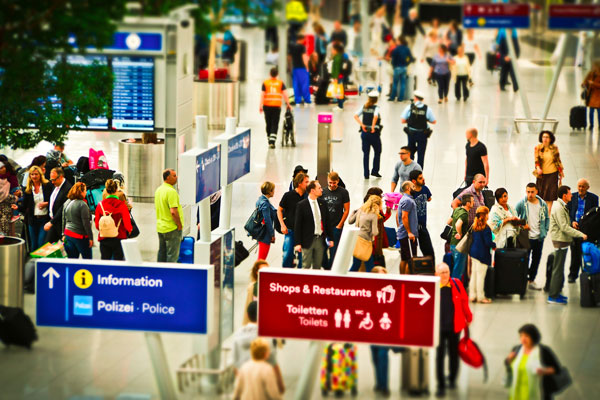In the first nine months of 2017, the nine largest publicly-traded U.S. carriers collectively posted a pre-tax profit of $14.7 billion, down 20 percent from $18.4 billion during the same period last year. The loss was primarily due to rising expenses, including labor, up 8.1 percent, and fuel, up 17 percent.

Hurricanes Harvey and Irma in late August and early September were especially disruptive to airlines, leading to flight cancellations and higher fuel costs. United Continental was hit the worst by the storms, as Houston is its second-largest hub.
Ancillary Fees Grow Airline Revenue
Although profits were down from 2016, revenues continued to climb thanks to ancillary fees. Examples of these fees from non-ticket sources include a la carte features, commission-based products, advertising and baggage fees.
The top 10 global airlines—United, Delta, American, Southwest, Air France, Ryanair, easyJet, Lufthansa, Qantas and Air Canada—generated as much as $28 billion in 2016 from such ancillary revenue, according to an October report by IdeaWorks. This figure is up more than 1,200 percent from only $2.1 billion in 2007.
Spirit Airlines’ ancillary revenue as a percentage of total revenue stood at 46.4 percent, or $49.89 per passenger, the most of any other carrier.
Airports Seek to Increase Revenue As Passenger Satisfaction Rises
According to Airlines for America (A4A), airports are lobbying Congress to raise the Passenger Facility Charge (PFC), a tax each passenger pays for passing through an airport. (Customers currently pay an average $63 in taxes on a typical $300 ticket.) This comes despite airports collecting a record $28.8 billion last year in fees and taxes, up 7 percent from 2015. U.S. airlines are urging Congress not to increase the PFC.
Nevertheless, overall passenger satisfaction with North American airports rose to its highest-ever level, according to September’s J.D. Power 2017 North America Airport Satisfaction Study. On a 1,000-point scale, satisfaction came in at 749, up 18 points from last year. The two biggest contributing factors were improved baggage checking and food, beverage and retail. The U.S. Department of Transportation reported in October that carriers mishandled baggage at a rate of only 2.45 per 1,000 passengers in August, a significant improvement from the same month in 2016 (3.15 per 1,000 passengers).
Airline Executives Optimistic Of Increased Travel Demand
The U.S. economy grew 3 percent in the September quarter, following a 3.1 percent gain in the second quarter. With the economy improving and consumer confidence at multiyear highs, airline executives expressed optimism in continued flight demand growth and profitability.
One example of increased demand is during the 12-day Thanksgiving season from November 17 through November 28. A4A expects as many as 28.5 million passengers to fly on U.S. carriers during this period, up 3 percent from the same period in 2016.
According to October’s Airline Business Confidence Survey, conducted by the International Air Transport Association (IATA), 80 percent of airline chief financial officers (CFOs) said profits improved in the third quarter compared to the same three-month period in 2016.
Other highlights from the survey include:
- An overwhelming 87 percent of CFOs were confident such profitability would persist or improve over the next 12 months.
- Eighty-six percent of CFOs reported increased passenger demand year-over-year in the third quarter.
- Lastly, 71 percent of CFOs expected traffic volumes to rise a year from now.

Passenger Traffic Forecast to Grow 5.4 Percent Annually
Cargo demand is also forecasted to grow at an annual rate of 3.9 percent, according to an October report by Dublin-based aircraft leasing company Avolon. During this 20-year period, 43,000 new aircraft are expected to be delivered, accounting for more than $4.2 trillion in goods and services. The firm says Airbus will deliver 18,000 aircraft, Boeing about 1,000 more, with smaller manufacturers—Embraer and Bombardier among them—making up the difference.
This outlook reflects strong passenger demand growth as airfare remains affordable and incomes rise around the world.
Interested in investing in the airlines industry?
Explore the U.S. Global Jets ETF (JETS) today!
Past performance does not guarantee future results.
The J.D. Power 2017 North America Airline Satisfaction Study measures passenger satisfaction among both business and leisure travelers, and is based on responses from 34,695 passengers who traveled through at least one domestic airport with both departure and arrival experiences during the past three months. The study was fielded between January and August 2017.
Administered by the International Air Transport Association (IATA), the Airline Business Confidence Index conducts a survey every 3 months to give a forward looking view of industry prospects.
All opinions expressed and data provided are subject to change without notice. Opinions are not guaranteed and should not be considered investment advice.
